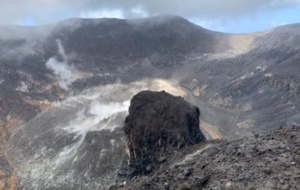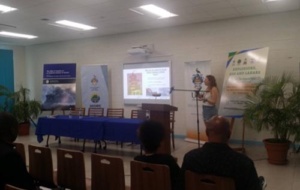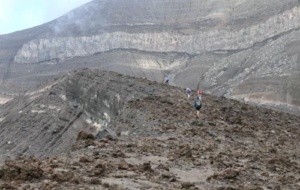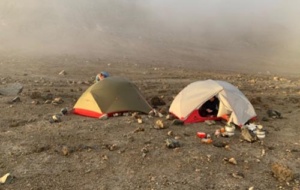La Soufrière volcano

Looking into the inner crater at La Soufrière volcano.
Research Training Fund Travel Report – Bei Bei Morrison Evans (2021, DPhil Earth Sciences)
La Soufrière volcano on the island of St Vincent in the Caribbean started erupting in December 2020 and continued erupting until April 2021. This period of volcanic activity has been extremely well studied by scientists across the world. A public outreach conference was held in Kingstown, St Vincent at the end of March 2023 called “Explosions, Ash and Lahars” to allow scientists to share what they’ve learnt with members of the public. The conference was welcomed by the Prime Minister Dr Ralph Gonsalves, the director of NEMO (National Emergency Management Organisation) Ms Michelle Forbes, the director of the UWI-SRC (University of the West Indies Seismic Research Centre) Dr Erouscilla Joseph, and organiser Prof. Richard Robertson.

My presentation at the Explosions, Ash and Lahars conference.
I was fortunate enough to present at the conference and spoke about how I have used the rock samples collected at the time of the eruption to learn more about where the magma feeding La Soufrière volcano might be coming from. After the conference, all international speakers were invited to the Prime Ministers’ residence for a drinks reception, performances by local art/theatre groups and a few words from the Prime Minister himself. The whole day was an incredible experience.
The next day we were up at 5am to drive to Rabacca where the trailhead up to the La Soufrière crater begins. We ascended through tropical rainforest into the clouds hugging the summit of the volcano. By the afternoon the cloud had cleared and we had a spectacular view down into the crater. We walked around the entire crater rim, searching for a good location to camp for the weekend (not too windy, no strong volcanic gases, flat ground etc) and assessing the lavas in the crater that we planned to sample.
We found a few possible locations to camp so stashed our hammers and chisels there for the night, and headed back down the volcano, ready to return the next day. On our second ascent up La Soufrière we were slightly slower due to our bigger backpacks, but still made good time and had camp setup by lunchtime.

Walking along rim of inner crater at La Soufrière volcano.
We spent the afternoon in the field, labelling lava flow units and collecting rock samples. We headed back to camp for a cup of tea and some rice and beans before sunset at 18:30 pm. As the night drew in, the wind picked up and our tents experienced a battering, one tent ripped and the pole was bent out of place in another. The next morning, Richie Robertson from the UWI-SRC who was with us on the trip, and had been in contact with the volcano monitoring observatory for the duration of the trip, was informed the weather was only going to get worse…
So we decided to pack up the tents and spend a full day in the field, finishing what fieldwork we could. We identified 16 different lava flows and managed to sample 13 of them – a very successful field campaign!

Base camp inside La Soufrière crater.
The next challenge was to ship the samples from St Vincent back to the UK. After returning from the volcano and resting our legs for a day, we headed into Kingstown on the Monday, walking up and down the high street between the shipping office, brokers and port. We finally got the all clear and loaded the rocks onto a boat departing that evening.
We spent our final few days on St Vincent visiting other field areas including Layou, Rabacca valley, and ascending La Soufrière once more to try and access some of the older lavas to the north of the current crater. Unfortunately, some very big gulley’s stopped us reaching these lavas so we spent our time exploring the crater lavas further (the ones we sampled earlier) and found two more units! All of the extra samples we collected managed to fit in an extra hold luggage bag. And so it was time to head home, with our rocks only a few weeks behind us, on a banana boat somewhere in the Atlantic Ocean.
I would like to thank Univ for their contribution towards my trip to St Vincent, enabling me to attend the ‘Explosions Ash and Lahars’ conference, followed by a successful field campaign to La Soufrière. I greatly appreciate it.
Find out more about the range of travel grants and scholarships available to assist Univ students on our Travel Grants page or read further travel reports.
Published: 28 July 2023
